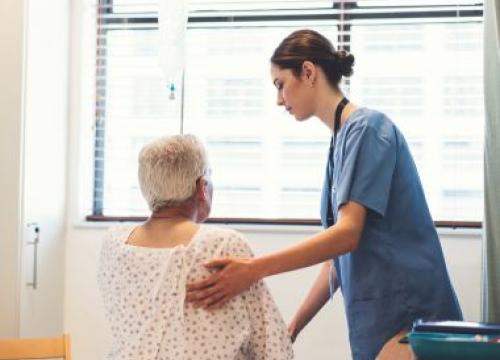A Possible New Gait Way: Spinal Cord Stimulation

Many people with advanced Parkinson’s disease (PD) suffer from gait (walking) dysfunction, freezing of gait and postural instability. These symptoms can cause falling, resulting in a multitude of injuries, a loss of personal freedom, caregiver stress and a reduction in the quality of life (Pirker & Katzenschlager, 2017; Samotus, Parrent, & Jog, 2018). Medications, such as levodopa, rarely helps with these specific motor symptoms, while deep brain stimulation (DBS) results are limited and unpredictable for these particular symptoms. The fact is, current PD medications, therapies or surgical procedures do not effectively address this debilitating unmet need. This lack of options might be changing, due to an intervention called spinal cord stimulation (SCS).
Surgically implanted, SCS is a device that alters nerve activity by sending a low-voltage electrical current to select areas of the spinal cord. These voltage settings are adjustable post-implantation, which allows for personalized optimization. SCS is currently used to treat people with chronic back and nerve pain, as well as for neuropathic pain, such as diabetic neuropathy, and chemotherapy or radiation induced neuropathy. Exploring its usefulness for people with PD has just begun.

Recently published in the journal of Movement Disorders, a study titled, “Spinal Cord Stimulation Therapy for Gait Dysfunction in Advanced Parkinson's Disease Patients” (Samotus et al., 2018), a six-month pilot study recruited five PD participants with advanced PD. These participants were chosen based on convenience. Participants were an average age of 71 with average disease duration of 14 years. Participants who had a stroke (or any other neurological diseases) and moderately severe parkinsonism in the context of unstable medication treatment (Samotus et al., 2018) were not included in the study. All five participants underwent mid-thoracic spinal cord stimulation surgery and a dorsal spinal cord stimulator was implanted in the epidural space (near the lower back).
This study evaluated SCS efficacy by clinical evaluation and objective gait analysis before and after surgery. A 20-foot gait detection mat equipped with pressure sensors — a relatively new technology (Muro-de-la-Herran, Garcia-Zapirain, & Mendez-Zorrilla, 2014) — was used to measure various features of gait such as step length, stride width, stride velocity, step time, stance, swing, and percentage of time one or two feet are on the ground. To measure freezing of gait, a timed sit-to-stand test was used, as well as an automated freezing detection program that measured changes in foot pressure.
The study also evaluated different frequency and pulse width combinations via gait analysis multiple times 1-4 months after surgery. Eleven frequency and pulse width SCS combinations were tested. Of note, the freezing questionnaire, the Unified Parkinson’s Disease Rating Scale (UPDRS) motor items, Activities-specific Balance Confidence Scale (ABC), and Parkinson’s Disease Questionnaire (PDQ-8) were given to all five participants at every visit.
Results
- Six months post-implantation, there was an average improvement of 33.5%, in the UPDRS motor score, 26.8% in the FOG questionnaire and 71.4%, in the ABC score.
- Significant improvement in all participants’ confidence to complete daily activities, especially around and outside the house, occurred in week six and improvements were maintained following week 10, resulting in an average improvement of 71.4% in week 24 compared to before the SCS implantation.
- The number of freezing episodes captured on the gait mat dropped quickly from an average of 16 before surgery to zero six months after surgery, per study participant, on levodopa and off stimulation.
- Stride velocity significantly improved by 42.3%, mean step length improved by 38.8% and the time in seconds for a participant to arise from a chair to a standing position improved by 50.3%.
- By week 24, two of the five participants were able to walk without assistance whereas they needed it before surgery, and three of the five participants reported that their activities of daily living were now only moderately affected by gait dysfunction, whereas they were severely affected before surgery.
- One participant reported no longer needing to use his wheelchair and was solely using a walker by the end of the study,
- No adverse effects were reported.
What Does This Mean?
First presented at the 21st International Congress of Parkinson’s Disease and Movement Disorders, this is the first study to use objective gait technology to assess SCS efficacy for people with advanced PD.
Ranging from significant improvement in all study participants’ confidence in performing activities of daily living, to one of the participants no longer needing a wheelchair, to sustained improvements in gait, the pilot study results are encouraging. Stride velocity improved by 42.3%, average step length improved by 38.8% and the time in seconds for a participant to stand up from a chair improved by 50.3%. Perhaps most impressive was the reporting of zero freezing episodes six months after SCS surgical implantation with no adverse effects.
Further, SCS technology proved to be personalized, as doctors were able to adjust technology after implantation in order to provide the optimal therapeutic value. Unlike most surgical procedures, SCS is reversible. Also, important to note, SCS runs on batteries — some are rechargeable, and others last up to 5 years (NIH, 2019).
Although it is a small pilot study, it nonetheless demonstrated that SCS may offer some significant therapeutic value for people with advanced PD. A larger and longer clinical study is warranted to see if these rather remarkable preliminary results can be replicated.
Learn More
The Parkinson’s Foundation believes in empowering the Parkinson’s community through education. Learn more about freezing, balance, gait and falls and Parkinson’s in the below Parkinson’s Foundation resources or by calling our free Helpline at 1-800-4PD-INFO (473-4636).
• Walking with Parkinson’s: Freezing, Balance and Falls
• Expert Briefings: Gait, Balance and Falls in Parkinson's Disease
• Podcast Episode 18: Stall the Fall
Related Blog Posts


